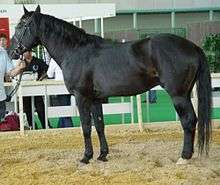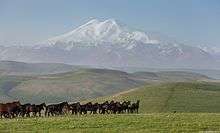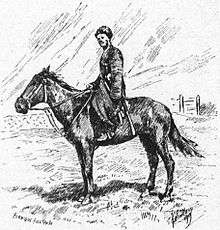Karachay horse
 Karachay stallion | |
| Alternative names | Karachay |
|---|---|
| Country of origin | Former U.S.S.R (Russia) |
| Equus ferus caballus | |
The Karachay (Karach.-Balk. Къарачай ат) is a horse breed developed in the Northern Caucasus. It came from highland Karachay at the rise of Kuban. The Karachay is registered with number 9354442 (breeder № 1278)[1] in the official journal of The Ministry of Agriculture of the Russian Federation (Moscow 2016).[2] They are developed by crossing regional horses with eastern stallions.[3] Karachay horses are summered in rugged mountain country where there are large changes in temperature and humidity, and wintered in the foothill and plains with some hay feeding. These conditions made the Karachay horse strong-limbed and sturdy.[3]
Breed Characteristics

The Karachay horse stands 14.3 to 15 hands high.[4] Karachay breeding has focused on creating a breed that is not only fast, but also hardy, obedient, low-maintenance, and able to withstand varied, even mountainous terrain year-round. Their hooves are strong and hard and do not need shoeing if bred and worked properly. They have a long head, often with a Roman nose, as well as agile, alert ears and well-developed whiskers. Karachay horses have a medium long, well-muscled neck, relatively straight shoulders and low withers. The mane and tail are long and thick. The body is strong and straight-backed. The limbs are also strong with generally good joints, bones and short, strong hocks; they occasionally have a tendency to be sickle-hocked, which is typical for mountain breeds. Karachay horses are black or black-brown and usually they do not have any white marks. They grow to a withers height of about 160 cm.[5]
The Karachay horse is inherently good-natured. It is very responsive to the rein and is not prone to acute excitement. This makes it an indispensable to the mountain tourism industry. The Karachay horse has been able to survive extinction mainly because of two things: its high fertility rate and its strong resistance to common horse illnesses. It is a hardy breed that requires minimal supervision.
History of the breed

The Karachay is a breed of riding horse that originated from the north-western regions of the Caucasus Mountains. It was first bred for use in the military and more in agriculture. It has been bred by Karachays around the 14th-15th centuries in the climatic and geographical conditions of the North Caucasus.[6]
In the beginning of the 20th century Karachay played a significant role, supplying most of the Kuban Cossack army`s regiments with chargers. Every year Karachay sold about 10 thousands of horses.[7]
In 20-s, during the period of recreation of horse breeding at North Caucasus which took place after the destroying civil war, people worked with Karachay breed according to the plan. In line with this, selective breeding of Karachay horses ensued. The Riding State Stud farm was created in 1927, and the State stud farm (Gosplemhoz) of Karachay horses was organized in 1929 and then reorganized in 1930 into Karachaevsky stud farm № 168, which bore J. Stalin`s name for some time.[6]
In 1935 the first volume of the studbook was established for the mountain breeds, registering 204 Karachay mares.[4] In 1937 State breeding center was created in Karachay Autonomous Oblast.[8]
In 1943 year J. Stalin deported the Karachays people to Central Asia and the Karachay breed was renamed as the Kabarda breed and the two breeds were combined.[6] Karachay breed was automatically referred to Kabarda breed and so named in the 2-nd, 3-rd and 4-th volumes of the studbooks. In 1980-s the discriminatory decision of referring Karachay horse to Kabarda breed was annulled and Karachay breed was again separate included into the 5-th volume of State stud book.[6]
In 1998 a group of Karachay-Cherkessiya`s horsemen with three Karachay horses ascended the east top of the mountain Elbrus, making an unprecedented act. In 1999 the horsemen ascended west top of the highest mountain in Europe.[6]
Uses
Karachay horse was at the same time a charger and a draft horse first for Karachays, and then Cossack military forces of The Russian Empire and the cavalry of the USSR were supplied with Karachay horses.[9] The modern Karachay horses and Anglo-Karachay horses can be found in different areas, that is, horse shows, competitions, mountain races, showjumping, tourism, agriculture. A lot of horses were exported outside Karachay. Also Karachay breed was used for developing[10] Tersk horse.
See also
References
- ↑ "ГОСУДАРСТВЕННЫЙ РЕЕСТР СЕЛЕКЦИОННЫХ ДОСТИЖЕНИЙ, ДОПУЩЕННЫХ К ИСПОЛЬЗОВАНИЮ (Породы животных). The National Registry Of Approved Selective Breeding Results".
- ↑ "Государственный реестр селекционных достижений, допущенных к использованию (ПОРОДЫ ЖИВОТНЫХ) (по состоянию на 08.04.2016 г.). The National Registry Of Approved Selective Breeding Results" (PDF).
- 1 2 Камбегов Б. Д. (1988). Коневодство и коннозаводство России. Москва: Росагропромиздат. p. 89.
- 1 2 "Dent, Bonnie L. Hendricks; foreword by Anthony A. (2007). International encyclopedia of horse breeds. p. 249.".
- ↑ "Welcome to the website of the largest Karachai horse breeding farm in Europe". Retrieved 2016-11-11.
- 1 2 3 4 5 "Карачаевские лошади". www.goldmustang.ru. Retrieved 2016-11-11.
- ↑ Невская В. П. (1964). Карачай в пореформенный период (PDF). Ставрополь: Ставропольское книжное издательство. p. 85.
- ↑ Ковтун П. А., Мишин Г. М. (1940). Государственный племенной рассадник карачаевской лошади (PDF). Микоян-Шахар: Кароблнациздат. p. 7.
- ↑ Б. П. Войтяцкий. Карачаевская лошадь // Конские ресурсы СССР. — 1939. — Р. 245.
- ↑ Елена ДМИТРИЕВА. "Ставропольский конный завод". Конный мир №5 за 2001 г.
Studbooks
- В. А. Парфенов, В. Х. Хотов. Государственная племенная книга лошадей кабардинской и карачаевской породы. Т. V. — Москва: Изд. МСХА, 1993. — 432 с. — ISBN 5-7230-0215-5.
- В. А. Парфенов, В. Х. Хотов. Государственная племенная книга лошадей карачаевской породы. Т. VI. — Москва: Изд. РГАУ-МСХА, 2010. — 287 с. — ISBN 978-5-9675-0435-8.
Sources
- Dent, Bonnie L. Hendricks; foreword by Anthony A. (2007). International encyclopedia of horse breeds (Pbk. ed. ed.). Norman: University of Oklahoma Press. ISBN 9780806138848.
External links
- «Сайт Российской Ассоциации коннозаводчиков и любителей карачаевской породы лошадей».
- «KarachaiHorse».
.jpg)